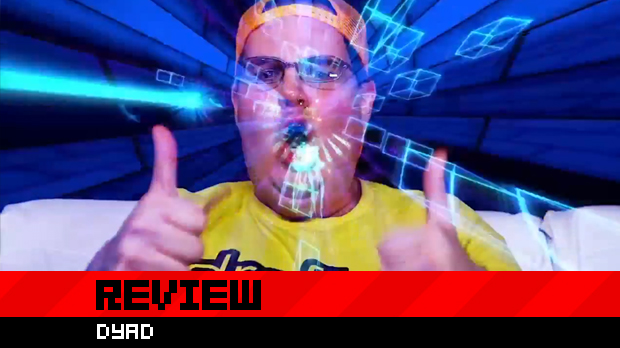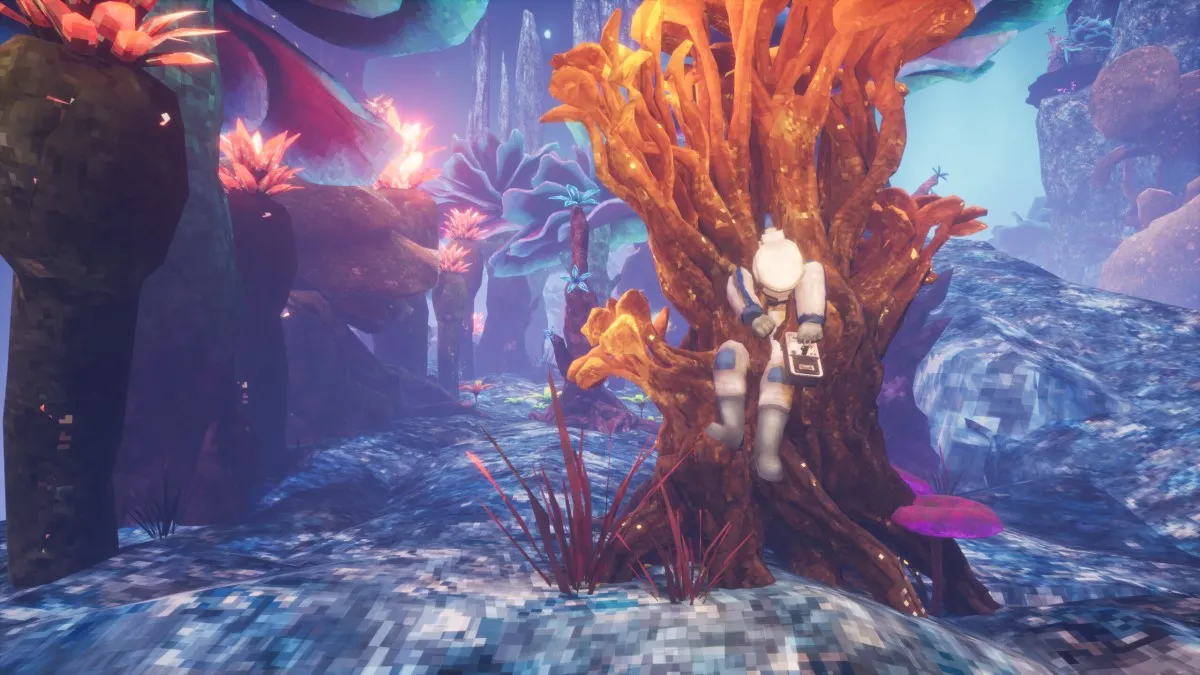“[Dyad] is a racing game with some shooting elements, puzzle elements, and there’s like a meta-game on top of it that sort of comments on your state of mind when you get into the flow state of playing the game.”
That’s how Dyad’s creator Shawn McGrath explained the game to us at PAX East last year. I have a much simpler explanation:
Dyad is like Amplitude combined with Torus Trooper and sniffing bath salts. Like sniffing bath salts, I can’t outright recommend it but I can say it’s one hell of a time!
Dyad (PlayStation Network)
Developer: ][ Games
Publisher: Sony Computer Entertainment
Released: July 17, 2012
MSRP: $15 ($11.99 with a PlayStation Plus subscription)
The difficult thing with describing, assessing, and scoring Dyad is that it has few constants in its design. Each of the game’s 27 levels — 26 of which have an entirely different trophy level — has its own unique goal, visual style, and mechanics. Throughout all of them, you progress forward, move your squid-like avatar in a loop (think Gyruss or Amplitude), race toward a goal, and do it all to an eclectic electronic soundtrack.
The appeal of Dyad is in its trippy-ass-balls visuals and incredibly fast twitch-based gameplay. Unfortunately these two things have a way of nullifying the enjoyment of the other, at times. The intense gameplay will keep you far too busy to appreciate the visuals, while the visuals are far too busy for you to thoroughly enjoy the gameplay. Since the backdrops and enemy types change level-to-level, this isn’t always a major issue but it it is more often than not. The developer insists that this is a game that you play by feel, but a proper game feel will always be dependent on clear visual and audio cues which are far and few between in the psychedelic tunnels of Dyad.

On it’s most basic level, Dyad centers on pairing enemies (orange or blue) by shooting them and grazing their center to fill your boost ability. Once you boost (read: Lance), you can tear right through enemies and go even faster. The game eventually introduces enemies that can stop your lance move and enemies that create a speed-up zone when linked with another. The rules of Dyad are constantly in flux, as is the music which reacts to your movement, speed, and performance. There are a couple sublime moments when the blurred action and high-tempo music created a surreal experience that I’ve only had with a couple games before.
If your only goal is to reach the game’s immense, brain-melting 27th stage, you won’t be too bothered by the confusing visuals. However, if you want to place high on the leaderboards, you’ll need luck and one hell of a sixth sense because these levels come at you fast. As for beating the trophy levels that unlock after you score a three-star rating on a level — well, good luck! It can be done but coming to terms with the perplexing visuals, shifting mechanics, and lengthy stage explanations will take some time and dedication for most players. McGrath can blaze through these levels, but who knows a game better than its creator (especially on launch week)? You’ll either get by on luck or by being a more patient, low-scoring player.
If one word describes Dyad it’s “exhausting.” Keeping up with the ridiculous speed of the stages is exhausting. But, most of all, it’s exhausting to have to relearn how you play 27 times. Though Dyad’s main menu is slick, it’s in-game briefings are a mess. The enemy icons aren’t accurate, the wall of text descriptions ruins the flow of the game, and there are rarely visual explanations of mechanics. Whether intentionally or not, Dyad is not a game eager to please players. It’s a game for survivalists wishing to prove something within the game’s ruthless tunnels.

However, each stage does have a remix mode that lets you alter the visuals and audio, all while playing the level without a fail state. It’s a nice addition that can produce some great eye-candy but it’s not likely to keep any sober bodies in front of the TV for long. The same can be said of Dyad as a whole. It’s a game made of gimmicks that can be enjoyed and mastered, but they are all just gimmicks in linear levels, at the end of the day. Though the game has latched onto the minds of some other reviewers, its hooks never quite got a grip on me. I couldn’t help but feel apathetic toward scoring high. I also couldn’t help but get angry at many levels that have enemies and mechanics that are as novel as they are frustrating.
Some of the game’s levels do a great job of turning everything you learned so far on its head. One of the early trophy levels requires the player to link enemy pairs by their audio cues instead of visuals. It’s incredibly tricky but has a unique thrill to it, once it sinks in. Most of the trophy levels are brutal and not very interesting. Some are just plain unfair. One starts the player off at maximum speed, tasked with dropping to a still state. You accomplish this by colliding with enemies, but it’s all so random that you don’t feel in control. It’s just a matter of luck with a bit of skill involved. A good arcade game shouldn’t be centered on luck.

Dyad is a simple game complicated by including a hundred simple ideas in the same package. It’s a packed closet full of items once individually wrapped but now they form an avalanche with you buried underneath it all. Some players may welcome the madness, but I couldn’t look past the game’s mixed messaging. On one hand, Dyad wants to be a classic arcade game where leaderboards occupy players’ minds. On the other, it wants to be an ambitious, navel-gazing experiment that culminates with a lengthy light show that makes the ending of Fez look like a Lite-Brite.
Dyad is an interesting drug but one that only gets you so high for so long. It’s side-effects and complications will get in the way of your mile-wide high, but, hey, everyone’s high is a bit different. Maybe you’ll enjoy it. Or maybe you’ll play Dyad for 20 minutes and jump off your roof, thinking you’re a dragon.
Regardless, Dyad is not substantial or well designed enough to occupy this body’s time once its effects wear off. The games’s visuals that recall MTV’s Amp are a treat and its manic gameplay is challenging, but these two elements never quite gel together. Also, it made me shit my bed last night. Thought you should know.





Published: Jul 19, 2012 02:00 pm